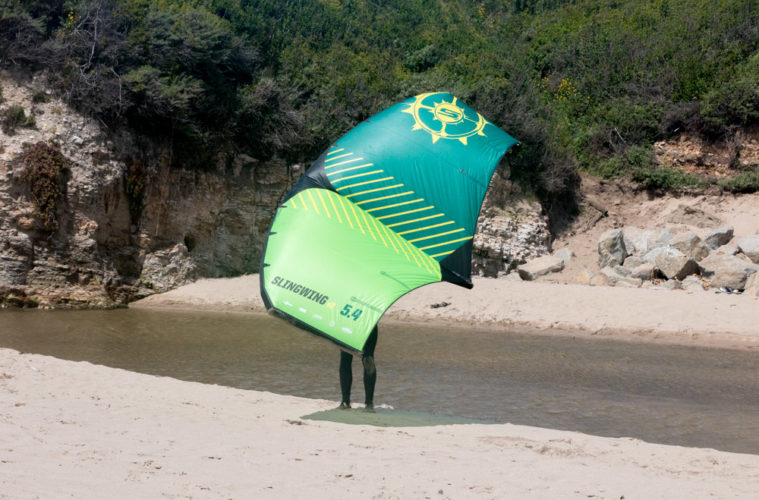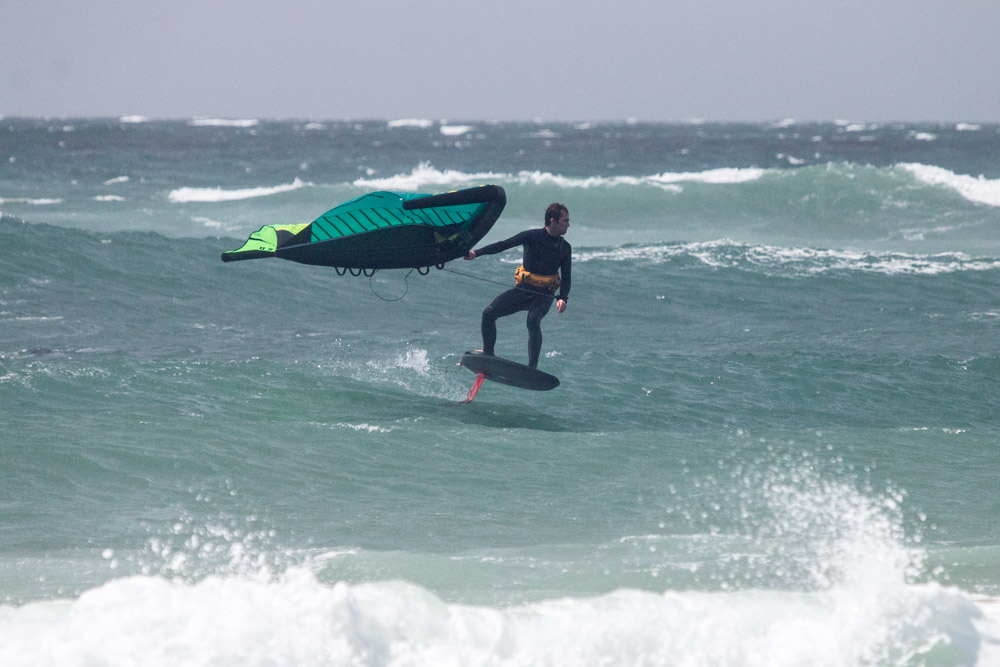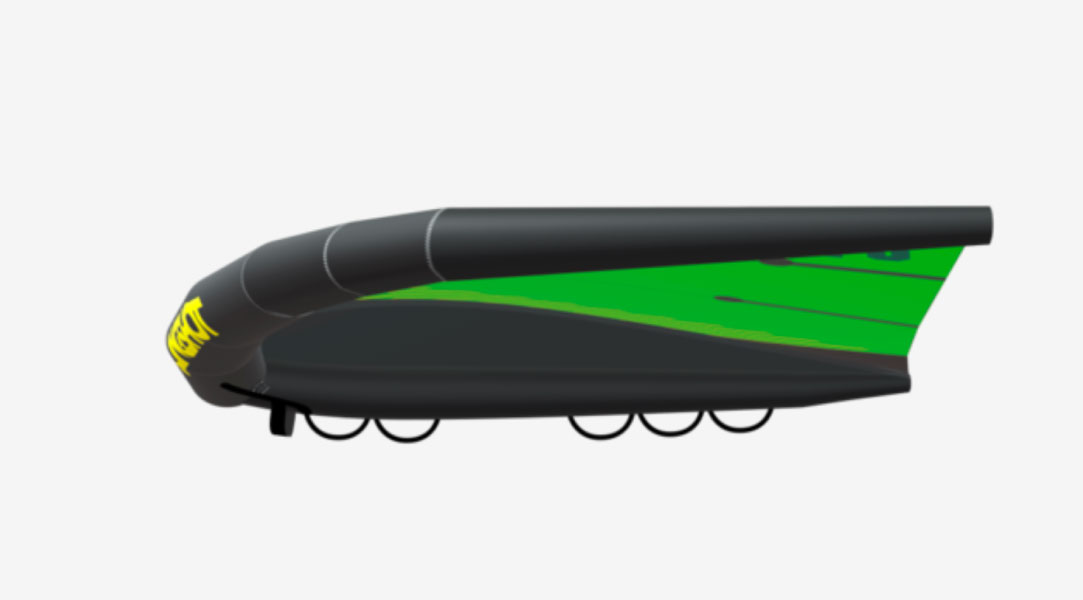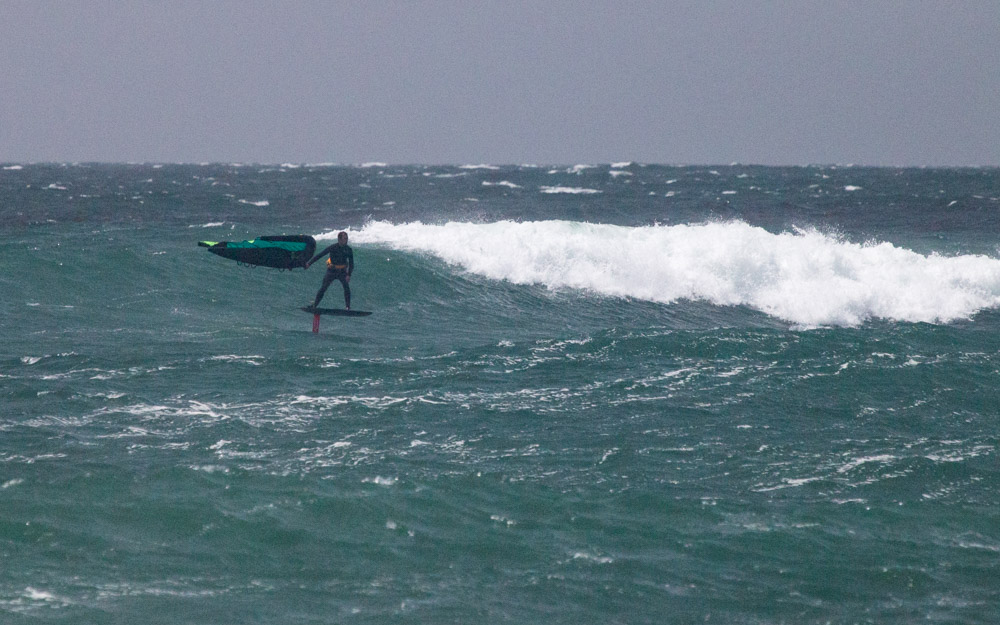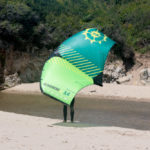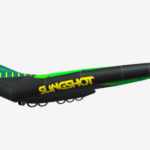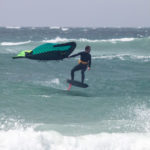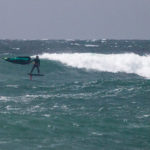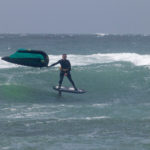SLINGSHOT SlingWing V2
Sizes Available: 3.2, 4.0, 4.4, 5.4, 6.4m
Sizes Tested: 5.4m
Slingshot Says:
The all new SlingWing V2 has an ultra-lightweight construction; half the weight of the V1 original. A lightweight build provides for effortless wrist control and oscillation cancellation while luffing the wing and leaving the power behind you. Beginners will benefit from reduced arm fatigue in light air conditions, while advanced riders will find it dramatically easier to get the wing flying for deep water starts on tiny boards.
Other features include 5 soft, comfortable handles which help you get just the right angle for that perfect, endless ride. A Cambered Dihedral shape gives you stability and lets you harmonize the wind, body and board into speed and control. The SlingWing V2 is made of extra tough D4 canopy material that is matched with double leading-edge bladder seams allowing for higher PSI inflation and more added tension across the wing, for NO FLAPPING.
The attention to detail extends past the wing itself. At Slingshot we understand how fun it is to take the SlingWing into the waves, and that getting rinsed is part of the game.
Visit for more info: www.slingshotsports.com/SLINGWING-V2-GREEN
Tkb Says:
There’s been a ton of anticipation over the second coming of Slingshot’s SlingWing. Last year the SlingWing Classic V1 released with a ton of tech features that had been incubating in the Slingshot design lab for years. While the Classic V1 scored an innovation field goal, the sum total of all the parts and gadgets amounted to a lot of extra weight that sacrificed agility and performance. This year the Slingshot team has completely rebooted the SlingWing product with a ground-up redesign that focuses largely on agility, performance and feel. The SlingWing V2 features much narrower diameter inflatable spars with the leading edge and boom being much smaller and more aerodynamic. The canopy features a completely different shape and profile, and most noticeably, no longer features a window which makes the airframe one of the lighter options on the market and gives the wing extra agility, improves hover performance and makes the wing more manageable for smaller riders.
The SlingWing V2 features a simplified handle layout with standard loop-style handles. There are two handles down the middle of the boom for the front hand (note the prototype we tested had one) and three handles for the back hand, as well as Slingshot’s Y-handles at the intersection of the boom and leading edge. There’s a single hover handle on the leading edge and an intermediary transfer handle between the hover handle and the boom handles. The new handle layout is much simpler and reduces weight compared to the SlingWing V1, while still giving the user a large variety of handhold positions. We used the front boom handle and the middle loop of the back handles exclusively, but those with longer arms or riding unhooked on long tacks will appreciate the last boom handle to get a wider hand stance and straighten out arms for less fatigue.
The hover handle on the leading edge does a good job of depowering the wing while giving it positive lift that helps you focus on riding waves when the wing is in hover mode. Slingshot incorporated a patch under the leading edge handle that protects your hand from chafing on leading edge seams which is a really nice feature. The intermediate hover handle at the very front of the boom will likely prove helpful to beginner riders who need some help making the transition from the hover handle back to the boom’s control handles. This intermediate handle can also prove helpful on waterstarts, allowing you to start with one hand closer to the controls, but more advanced riders might find little use for this handle.
The Y-handles are positioned correctly and allow you to change the cant of the wing during unhooked upwind riding and also allows fine-tuning of your hand position forward and aft. Some people seem to think the lower handle helps going upwind and the upper handle helps for broad reaches. If you are using a harness to race upwind, you won’t need the Y-straps because the harness takes all the load and disperses it along the center of the boom (our prototype came with harness mounting points but did not come with the actual production harness line or with a production wrist leash). Right now, the decision between using a harness and strong-armed riding is a personal preference””some riders swear by the Y-handles while others could do without them, but if you are a fan the Slingshot Y-handles are comfortable and perfectly positioned.
We found the new handles along the boom to be more comfortable and ergonomic than the previous SlingWing V1. There’s thicker EVA foam sewn into the webbing to create a more 3-dimensional shape against your palm and the loops are fairly large so they’re easy to grab. The Slingshot handles feature webbing that is a bit wider than other brands, but the durometer isn’t super stiff so it conforms to your hand and has a good feel. Slingshot seems to have struck an excellent balance between handles galore and weight, giving you the essential handles you need along with some extras for riders of all sizes and skill levels, yet the wing still falls in the category of lightweight and agile.
In terms of performance, this is where the SlingWing V2 makes a huge jump forward. The new design uses a smaller diameter leading edge and a smaller boom that incorporates a luff strut to give the center of the canopy a bit more profile””this seems to give the wing excellent range and a wider sweet spot when sheeting. We thought the SlingWing did a decent job of delivering good upwind angles while still having that user-friendly sheet and go feel. The yaw felt stable but nimble when you need it and the wing feels balanced and easy to control. Some wings can be a little jittery along the yaw access when in hover mode, but the SlingWing’s dihedral seems to stabilize the wing’s position so the rider can focus on linking up swells rather than keep the wing under control. Since we were testing a 5.4m wing, we did find that we got the best performance when inflating the wing to its highest pressure. Across the board, we’ve found that the wings with the smaller diameter booms require higher inflation pressure which is often above the recommended PSI by the manufacturer. When inflated to our liking, the wing feels like it generates intuitive levels of power and the boom, despite its smaller diameter, was solid and the transfer of power during pumps felt crisp and precise.
The shape of the canopy uses a square-like sail plan that gives the leading edge an elbow before it sweeps back into the wingtip. This design seemed to give the wing a ton of surface area while keeping the wingtips out of the water. At first, it felt like that elbow was itching to get caught in the water, but we got used to the boxy wingtip hovering over the water, finding minor touchdowns were easy to correct.
When it comes time to turn downwind and start chasing swell, the 5.4m did a good job of hovering while riding waves with good positive flotation that seemed to sit comfortably and remained easy to control. Our test wing was a fairly good-sized wing at 5.4 meters and we were somewhat surprised by its nimble handling. For those riders using small volume sinker boards who tend to ride with more power, the 5.4m is a very capable wing that gives you the power to waterstart in lighter conditions while keeping the fun factor high in waves or riding big swell.
The SlingWing V2 is an entirely new design that dropped a ton of weight and introduces an entirely new airframe that delivers performance that works for all skill levels. If you had a SlingWing Classic V1, the V2 is a completely different animal. The V2 is a great entry-level wing offering up the perfect blend of features and user-friendly power and handling that will take you from beginner all the way to expert.
Want more tips and tricks on foiling skills and technique? Get our new Foil Instructional Guide. Comprised of two guides in one: the wingsurfing instructional chapters walk you through the basic concepts of wingsurfing, navigating gear purchasing, outlines major mistakes to avoid, and offers up clear and concise instructional tutorials on basic to advanced wingsurfing moves. Sign up for FREE digital access HERE.


